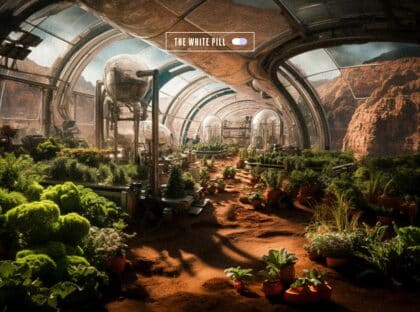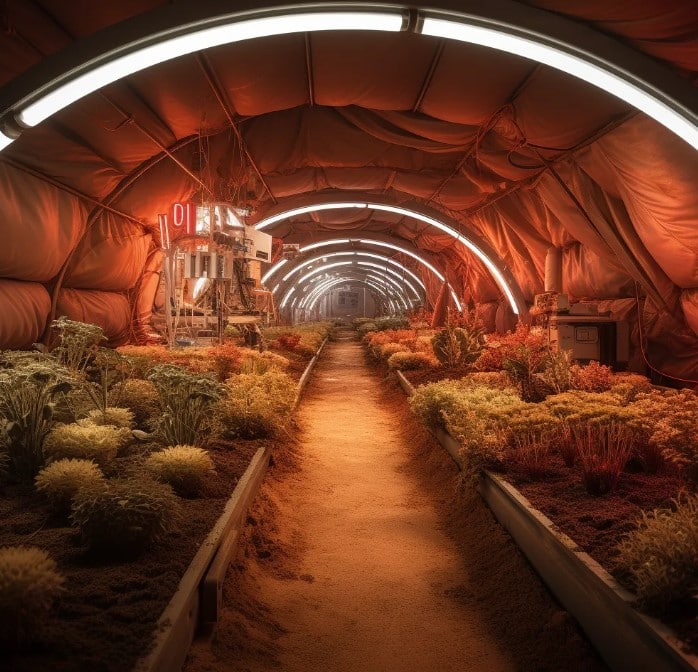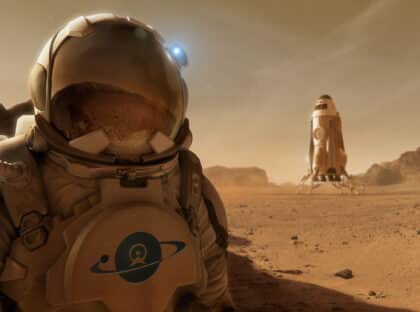
By Brandon Gorrell & Owen Lewis, TheWhitePill.PW (09.23.23)
Reader, hi, it’s the 24th issue of the White Pill, and it’s easily our best issue yet. This one has a lead story: an interview with the legendary Robert Zubrin, founder of Mars Society, prolific space and science writer, and preeminent aerospace engineer. We discuss farming on Mars, and how to get rich off of Martian technology.
While there’s significant investment and R&D into terrestrial biotech applications, Martian biotech is underserved, and could doubly produce terrestrial benefits. These benefits could translate into cash flow, which the Mars Technology Institute (MTI) — a Mars Society project “whose purpose will be to develop the technologies needed to settle” Mars — could funnel back into more Martian research, and ultimately, Martian expeditions, Mars Society founder and prolific Mars author Robert Zubrin told me over Zoom in early September. In other words, the MTI has a business model to prove: can it develop Martian technology here, spin it into products or license the intellectual property (IP), and become a financial powerhouse?
“We want to create MTI as an engine of invention to enable Martian settlements, and therefore an engine of finance to enable Martian settlements. And also, to prove the validity of the business model,” he said. “In addition to having a staff of professional researchers, we’re going to take proposals from people who are willing to do research on their own time, if, for instance, we pay for the materials. We’ll fund the proposals that are the most meritorious in terms of their potential impact on Mars, the potential value of IP they could produce, and the credibility of the teams proposing them. This is going to greatly amplify what we do. It will increase our productivity by an order of magnitude. And the MTI will own the IP.”

The first interview I did for the White Pill was with Delian Asparhouv, co-founder of Varda Space Industries. I gave the interview while the results of their first in-space drug manufacturing run were being transmitted from low-Earth orbit to Earth. Going into the conversation, my intention had been to prompt Delian about humanity’s far future in space, because I thought that would make for fun reading. We ended up talking about the viability of space-based business models almost the entire time, and I sensed that he was honed in on the urgency of unlocking demand for cislunar activity with a value framework that would make its investors rich. Space will necessarily be the domain of entrepreneurs, Delian said — commerce will be the subject of space. There’s no other realistic way to settle other planets.
Zubrin thinks MTI could make its investors rich. It could license its IP to other companies and collect royalties. It could invite investors to fund spin-off companies based on MTI inventions for equity. Maybe, Zubrin thinks, MTI could end up with an empire of companies based around the inventions MTI produces. “Ultimately, if we’re truly successful, some of these inventions could be so productive as to make the MTI a financial powerhouse, which will enable us to finance the settlement of Mars.”
Obviously, anything the MTI comes up with needs to be a solution for both a Martian problem and a terrestrial problem — just one or the other doesn’t work. The demand needs to be on both planets. Therefore, at the top of Zubrin’s priority stack is updating food’s relationship to energy. “Vegetarians always talk about how inefficient meat is, because you take a given amount of corn, and you feed it to a cow, and maybe you only get a small percent of the caloric value that was in the corn out in the form of meat,” he said. “So by going from vegetable to meat, you’re cutting the value by factors. But the greatest inefficiency in that process isn’t going from vegetable to animal, it’s going from sunlight to vegetable.
“Take an Iowa corn field, which is among the most productive agriculture ever practiced. If you take the solar energy hitting that cornfield, and compare it to the energy coming out in the form of corn, it’s 0.2 percent efficient. That’s how efficient the most productive agriculture in the world is.
“An Iowa corn field produces 12 tons per hectare, per year. That boils down to 30 kg per day of corn. So if you fed people with nothing but a kilogram of corn a day, which would be a pretty lousy diet, that means a hectare could support 30 people. If we make the diet more interesting, with some fruits and a little bit of meat, let’s say the hectare would support 20 people. That means if you wanted to have a 20,000-person Martian colony — the size of a pretty small town — that’s 1,000 hectares. 10 square kilometers. Over six square miles. That’s huge for a small town. And for a million people — a medium-sized city — you’d need 50,000 hectares. This is unthinkable on Mars. And that’s assuming you have the same productivity in Martian sunlight as you do on Earth. But Martian sunlight is only half as strong as Earth sunlight!”
If it’s not clear yet, endless Iowa-style cornfields stretching to the Martian horizon aren’t on the menu, at least in our lifetimes. It’s not just that the planet gets under half the amount of sunlight that Earth does. Because Mars’ atmospheric pressure is less than a percent of Earth’s, liquid water would immediately boil away when exposed to the Martian air. The Martian atmosphere is composed mostly of carbon dioxide, with virtually no oxygen, and plants require oxygen for respiration. During daytime, temperatures at the Martian equator can reach up to around 70°F (20°C). However, they can plummet sharply once the sun sets, dropping to values as low as -80°F (-62°C) during the night, which would be fatal to any crop.
But Mars will have to produce its own food. If it uses agriculture, it will have to be in artificially lit underground tunnels, or pressurized greenhouses on the surface, which will severely restrict arable acreage. Like American agronomist Norman Borlaug, who developed a high yield wheat cultivar that wasn’t sensitive to day length and helped herald the Green Revolution, Martian technologists are going to have to innovate to create ultra-productive agriculture — or other highly efficient ways of producing food. This technology could be exported to Earth, where it could, for example, allow us to use half the farmland to produce the same amount of food.
To read the full interview, please click here.


